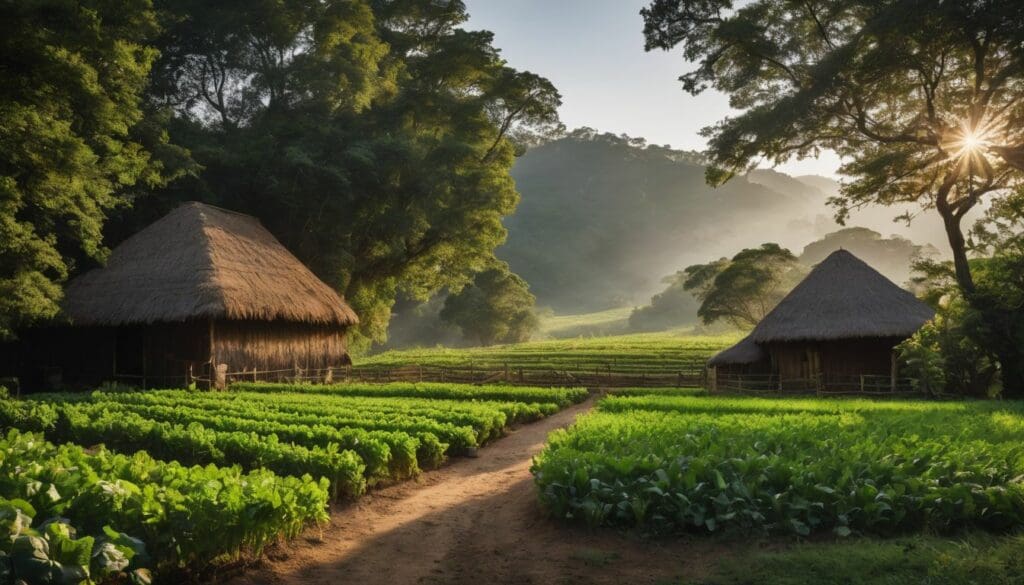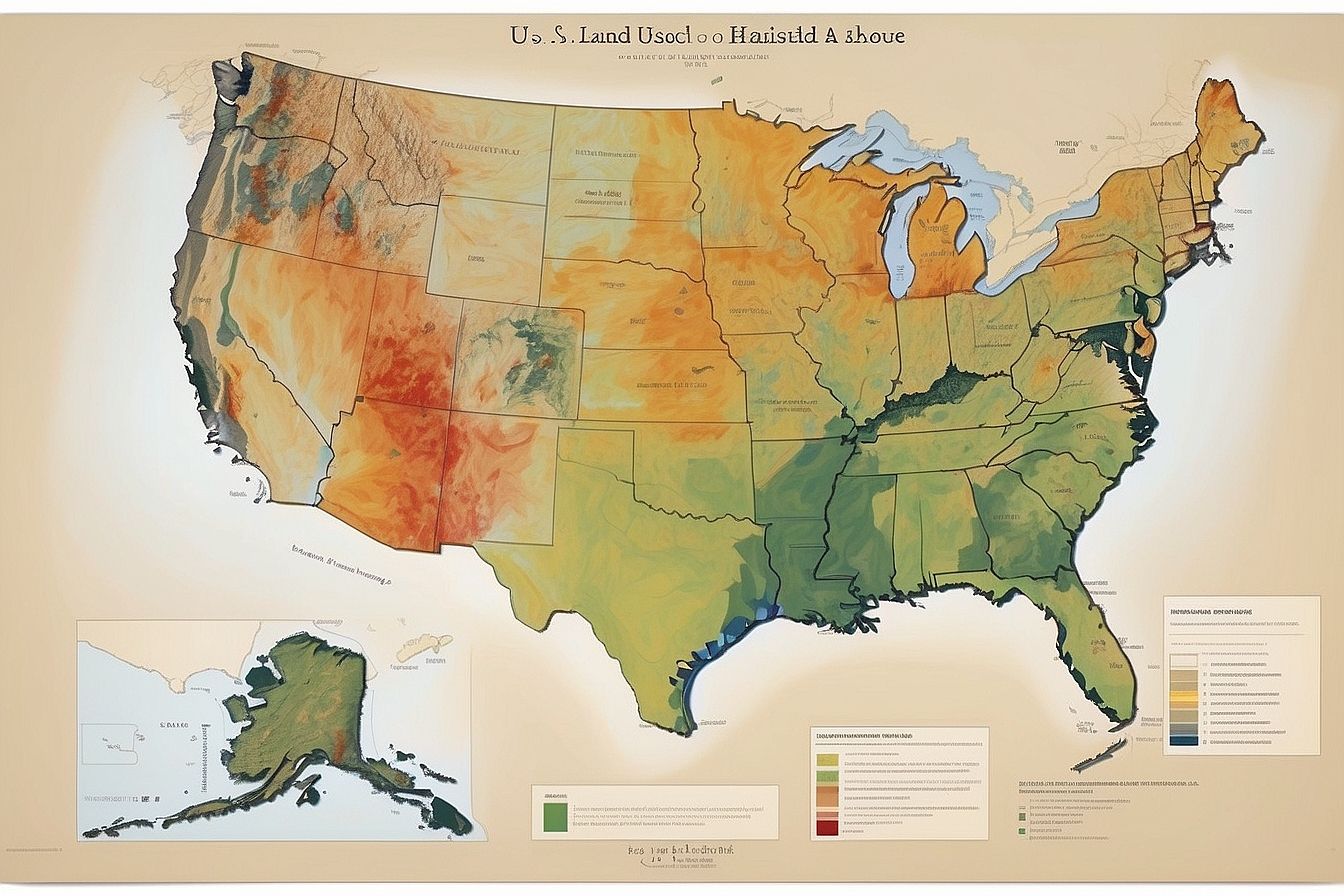We’re all on a mission for a greener tomorrow, and the real struggle is finding that perfect harmony between bountiful harvests and conserving our natural treasures. Like so many others, this conundrum has been at the forefront of our minds.
It’s heartening to share that agroforestry could well be the beacon we’ve been searching for – with potential to boost farm productivity by a smashing 40%. Let us take you by the hand as we explore how weaving trees into your agricultural tapestry can not only enhance crop yields but also nurture environmental well-being.
So come along, there’s plenty of room on this journey for growth!
Key Takeaways
- Agroforestry ingeniously merges the practices of farming and forestry, offering a sustainable way to manage land. It can boost farm productivity by up to 40% and helps achieve a balance between high yields and environmental conservation.
- Practices like alley cropping, forest farming, riparian forest buffers, silvopasture, and windbreaks improve soil health, control erosion, support wildlife habitats, increase biodiversity and assist in climate change mitigation.
- This approach benefits both farmers and the environment by providing habitats for beneficial insects crucial for natural pest control while enhancing air quality through carbon dioxide sequestration.
- By integrating trees into agricultural systems, agroforestry promotes sustainable farming techniques such as crop rotation that result in resilient ecosystems capable of withstanding harsh weather conditions.
- Agroforestry not only supports economic stability for small – scale farmers but also contributes to food security by allowing diverse crops to flourish even in challenging environments.
What is Agroforestry?
Agroforestry is a sustainable land use system that integrates trees and shrubs with crops and/or livestock, creating a more productive agriculture while promoting environmental quality.
It involves the intentional combination of agriculture and forestry to create diverse, resilient, and regenerative landscapes.
Definition
We see agroforestry as the creative blend of agriculture and forestry, where intentional integration of trees into crop and animal farming systems takes centre stage. This sustainable land use method not only ramps up biomass production but also fosters a harmonious relationship between ecological functions and agricultural productivity.
By weaving together the strengths of both sectors, we cultivate an environment that champions biodiversity, enhances soil conservation, and bolsters ecosystem resilience. It’s more than just planting trees; it’s about fostering climatesmart farming that invigorates our lands while securing food resources.
Now let’s explore how this works in practice by delving into different agroforestry practices and their benefits.
Benefits
Agroforestry delivers a range of benefits to both the environment and agricultural production. Integrated trees within agroecosystems enhance biodiversity, improve air quality, and sequester carbon dioxide, contributing to climate change mitigation.
By creating diverse ecosystems, agroforestry systems also provide habitats for wildlife and beneficial insects crucial for natural pest control.
Additionally, adopting agroforestry practices helps in preserving soil health by reducing erosion through windbreaks and riparian forest buffers. The cultivation of perennial crops aids in enhancing soil fertility while minimising the need for chemical inputs.
Agroforestry Practices
Agroforestry practices include alley cropping, forest farming, riparian forest buffers, silvopasture, and windbreaks. These techniques combine the benefits of agriculture and forestry to create sustainable land management systems.
Alley cropping
Alley cropping involves planting crops between rows of trees or shrubs. This allows for the combined production of annual crops and trees or shrubs in the same space, providing multiple benefits such as improved soil fertility, erosion control, and increased biodiversity.
By creating a diverse agroecosystem that combines woody perennials with annual crops, alley cropping promotes sustainable land stewardship and supports conservation efforts. Additionally, this practice plays a crucial role in traditional land management systems and offers a practical solution for farmers seeking to implement agroforestry methods.
In alley cropping systems, the close proximity of trees and crops enhances the overall productivity of the land while promoting environmental sustainability through effective erosion control measures.
Forest farming
Forest farming involves cultivating crops, herbs, and non-timber forest products under the canopy of a managed forest. This practice promotes biodiversity, reduces soil erosion, provides habitat for wildlife, and supports sustainable land management.
Forest farming integrates trees with agricultural crops or livestock to create a balanced ecosystem that benefits both the environment and human communities.
Incorporating forest farming into agroforestry systems enhances ecological resilience and contributes to long-term conservation efforts. It also offers economic opportunities for small-scale farmers while promoting sustainable forestry practices.
Riparian forest buffers
Transitioning from forest farming to riparian forest buffers, we encounter another vital agroforestry practice. Riparian forest buffers involve planting trees or woody vegetation along water bodies such as streams, rivers, and lakes.
These buffer zones help in controlling soil erosion, reducing nutrient runoff into waterways, improving water quality, and providing habitat for wildlife. By strategically planting and managing these buffers, farmers can create a sustainable ecosystem that benefits both agriculture and the environment.
These diverse vegetated strips not only improve the health of the surrounding aquatic environment but also contribute to increased biodiversity on farms. The roots of the trees stabilise the soil along stream banks while their canopies provide shade that helps regulate water temperature for aquatic life.
Silvopasture
Silvopasture integrates trees and forage in a single system. Livestock graze within the same land where trees or shrubs are cultivated, providing multiple benefits such as improved soil quality, carbon sequestration, and animal welfare.
This sustainable practice also contributes to biodiversity conservation and creates a more resilient environment against climate change impacts.
Planting trees alongside pasture provides shade and shelter for livestock, reducing heat stress during warmer months. The dual-purpose nature of silvopasture not only boosts agricultural productivity but also enhances ecological stability by fostering harmonious interactions between animals, plants, and the natural landscape.
Windbreaks
Windbreaks are rows of trees or shrubs strategically planted to reduce the force of wind on crops and livestock. They act as natural barriers, protecting soil from erosion and reducing water loss through evaporation.
By creating a microclimate, windbreaks enhance crop productivity and provide habitats for beneficial wildlife, supporting biodiversity in agroecosystems. Farmers can integrate windbreaks into their agricultural practices to mitigate the impact of extreme weather conditions and improve overall farm resilience.
The strategic placement of windbreaks also helps in managing pests by disrupting their movement patterns and limiting damage to crops. Furthermore, these living fences contribute to carbon sequestration, aiding in climate change mitigation efforts while enhancing the aesthetic appeal of farmland.
Conclusion
In conclusion, agroforestry offers a sustainable approach to land use. It combines the benefits of agriculture and forestry, providing multiple ecological and economic advantages. Agroforestry practices, such as alley cropping and silvopasture, contribute to soil health and biodiversity while supporting agricultural productivity.
With its potential for mitigating climate change and enhancing ecosystem resilience, agroforestry presents an innovative solution for environmentally conscious individuals seeking sustainable land management approaches.
FAQs
1. What is agroforestry?
Agroforestry is a land use system that combines trees and shrubs with crops or livestock, blending aspects of agriculture and forestry to create more sustainable practices.
2. How does agroecology relate to agroforestry?
Agroecology involves designing agricultural systems based on natural ecosystems, which is exactly what agroforestry aims to achieve by incorporating forest management principles with farming.
3. Can multistrata agroforestry benefit my farm?
Yes, using multistrata agroforestry can increase biodiversity on your farm, creating layers of different plants that work together for better crop yields and healthier soil.
4. Is permaculture the same as agroforestry?
Permaculture includes many principles similar to those in agroforestry; it’s a philosophy focused on sustainable land use design that often integrates tree-planting with traditional agriculture.





